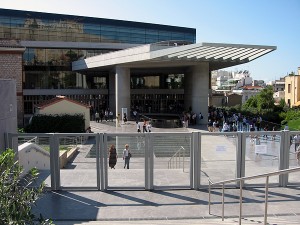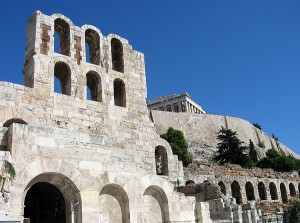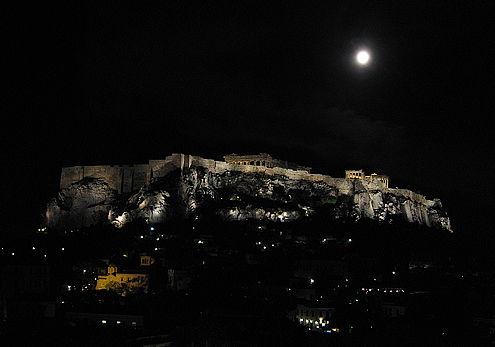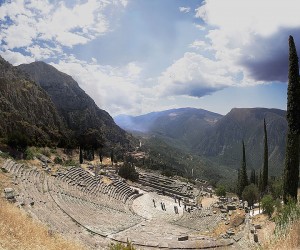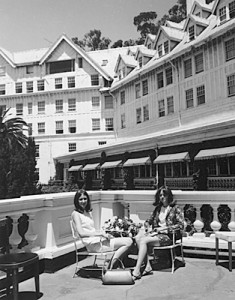Looking back, I think the first seeds for this trip were planted when I read The Camino, Shirley MacLaine’s account of her pilgrimage along the Santiago de Compostela Camino in northern Spain. I was inspired by her encounters with entities from past lives, her visions and revelations. I told myself that I’d like to take a similar journey someday, but one with better food and more comfortable accommodations. And here I was, nine years later looking over the breakfast buffet at my hotel in Athens thinking about Shirley and the meagre meals she was offered at the refugios along her 500-mile trek.
Socrates, my seat mate on the plane from Heathrow, told me that Greeks don’t do breakfast, and it was all too apparent from the offerings before me that this was the case. The cold hard-boiled eggs, dry bread, deli-sliced processed cheese and what I assumed was ham, canned fruit cocktail, and overly-thick Greek yogurt represented a veritable feast compared to the meals Shirley encountered on her pilgrimage, yet I longed for something more.
I headed for a cafe I’d discovered the day before that claimed to have the best coffee in the city. After seating myself outside beneath the awning, a waiter approached. I remembered Socrates telling me I must try bougatsa, a phyllo pastry with a creamy custard filling sprinkled with powdered sugar and cinnamon. I ordered a latte and asked if they had this classic Greek confection, but alas, no. From our brief interchange, I knew the waiter’s understanding of English was limited, and my ability to speak Greek was nonexistent. As he waited patiently, I heard myself say, “Pain au chocolat?” Now, I was totally aware that I wasn’t in France, but I thought – well, to be honest, I wasn’t thinking – it had just poppped out of my mouth. The waiter nodded and minutes later was back at my table with a large piece of chocolate layer cake. Deciding I may as well make the best of a botched communication, I dug in. And I have to tell you, it was one of the best pieces of chocolate cake I’d ever eaten.
After devouring every last crumb, I set off for the new Acropolis Museum. When I arrived, there was a long line and when I got through security, I learned that my ticket to the Acropolis did not, in fact, grant me entrance to the museum as had been advertised. The line for tickets was equally long, and I knew that the museum was closing early that day because of the national elections, so I decided to give it up and come back at the end of my trip.
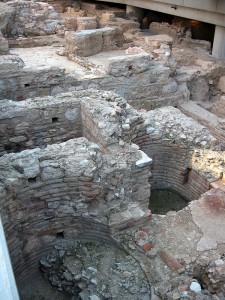 Before taking off, I examined what was visible of the ruins of an ancient city beneath the museum discovered when construction began ten years ago. The neighborhood, inhabited from the fifth century B.C to the 12th century, included private villas, bathhouses, workshops and cisterns, and the dig uncovered a treasure trove of busts, coins, children’s toys and cooking utensils. The site which had been filled with truckloads of sand to protect it during construction won’t be totally uncovered and open to visitors until next year, but I was fascinated by what I could see through the glass walkways leading up to the museum.
Before taking off, I examined what was visible of the ruins of an ancient city beneath the museum discovered when construction began ten years ago. The neighborhood, inhabited from the fifth century B.C to the 12th century, included private villas, bathhouses, workshops and cisterns, and the dig uncovered a treasure trove of busts, coins, children’s toys and cooking utensils. The site which had been filled with truckloads of sand to protect it during construction won’t be totally uncovered and open to visitors until next year, but I was fascinated by what I could see through the glass walkways leading up to the museum.
It was now late morning and I had no other plans for the day, so I joined the tourists and Athenians on the walkway on the south slope of the Acropolis. I wasn’t on the lookout for more monuments, but I had to stop to admire the Odeon of Herod Atticus, a stone theatre built in 161 AD. Still in use, the Odeon is one of the main venues of the annual Athens Festival.
As I continued meandering along some of the same streets and alleys I’d walked the day before, I was thinking how strange it was for me to be moving through the city with no map and no predetermined plan. Walking more slowly, stopping to observe whatever caught my attention, listening to my instincts – it had all worked surprisingly well on my first day in Athens. But a half hour into my after-dinner walk, I realized I had wandered into unfamiliar territory and I had no idea how to find my way back to my hotel. With the crowds, the lights and the souvenir shops, I was beginning to feel like I was trapped in a Twilight-Zone carnival where all the vendors looked exactly alike. But instead of giving in to fear of being irretrievably lost, I remained calm and just kept going. And after walking in what seemed like a maze for at least an hour, I found myself back in front of the restaurant where I’d had my dinner.
The labyrinth, a maze-like structure from Greek mythology, is often thought of as a symbolic form of pilgrimage, and in modern times it’s used to quiet the mind and to promote a contemplative state. The streets of the Plaka with my hotel, The Central, at the center of the maze, had served that purpose for me with the added bonus of helping me let go of a deeply-imbedded fear. I hoped that after this journey as I made my way back out into the world, I would have a broader understanding of myself and my place in it.

